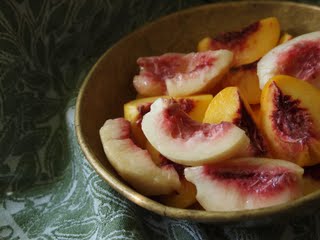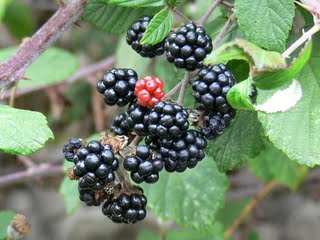 Don’t you hate it when the light starts slanting to remind you it’s autumn? This recipe catches the last of the really summery peaches and preserves them with a sugary papaya so you can enjoy them in the dead of winter with toast. I’m blowing my own trumpet a bit here, but I was simply amazed at how good this combination is – this is an extraordinarily good jam, packed with peachy aroma and body.
Don’t you hate it when the light starts slanting to remind you it’s autumn? This recipe catches the last of the really summery peaches and preserves them with a sugary papaya so you can enjoy them in the dead of winter with toast. I’m blowing my own trumpet a bit here, but I was simply amazed at how good this combination is – this is an extraordinarily good jam, packed with peachy aroma and body.
It’s nice here if you can find some white peaches (or nectarines) as well as some yellow ones. The fruit will be suspended in little chunks in the amber jam, and it’s nice to have a little variety in colour to look at. Peaches and papaya aren’t particularly rich in pectin, and they’re very, very sweet, so there’s less sugar here than you might expect; I have also added a supplementary apple with the juice of a lemon to add a little tartness and that all-important pectin for setting.
As with all jams, make sure you stir this constantly with a wooden spoon as it cooks to avoid burning the bottom of your pan. If you make a lot of jam (or even if you only make a bit), it’s a really good idea to spend a few pounds on a jam thermometer rather than relying on the cold saucer method, where you drip a little jam onto a cold object to see whether it’s setting properly.
To make about 2kg jam, you’ll need:
1 ripe papaya
2 ripe yellow peaches
2 ripe white peaches
1 small, tart apple
Juice of 1 lemon
Sugar (you’ll need to work out the weight – see below)
Sterilise some jars and a ladle.
Peel and seed the fruits. This is very easy with a peach – just quarter it and you should be able to peel the skin away with your fingers. Chop the flesh into chunks, being careful to reserve the juice. Weigh the fruit and any juice, and measure out some sugar weighing ¾ as much as the fruit. (In many jam recipes you’d use equal amounts of fruit and sugar, but these are very sweet fruits, and they don’t need the help!)
Pour the fruit, the lemon juice and the sugar into a saucepan with a jam thermometer, and bring to 110°C (230°F). The faster you can get it to temperature, the better the colour of the fruit will be preserved. Ladle the hot jam into jars, topping with a wax disc if you like, and seal immediately.
I’m still on an official blog holiday, but I’ve a couple of really great prizes to give away this week. For today’s competition, Eurostar have stumped up two tickets to Lille (you might remember reading about the little break I took there with a bunch of other food bloggers last month) for one reader.

